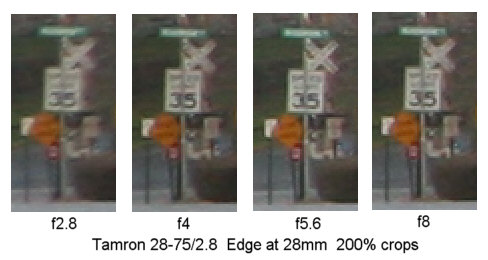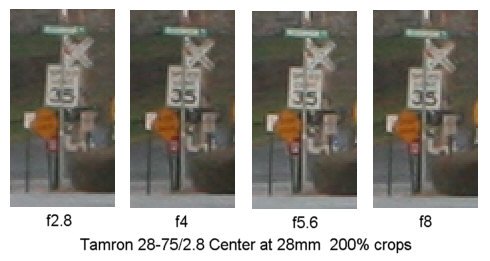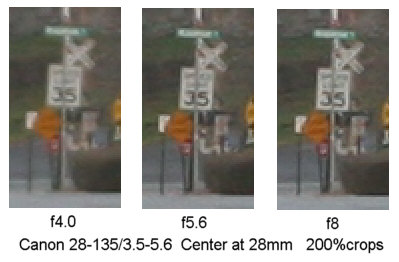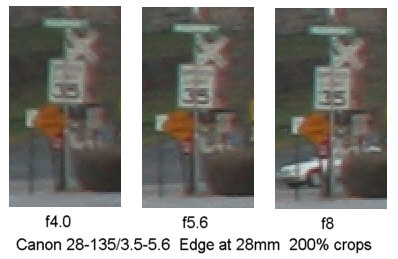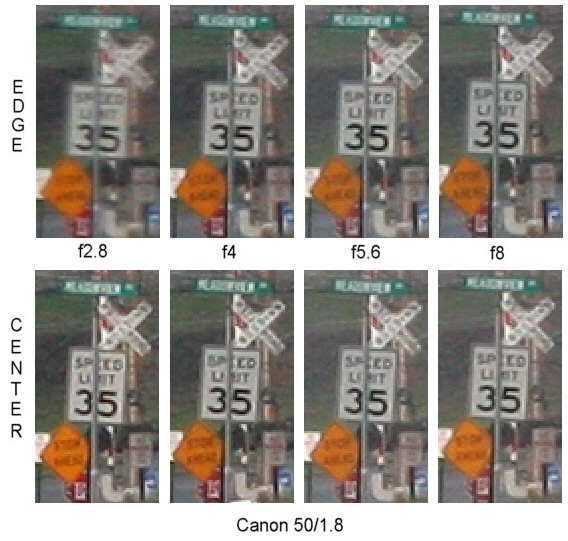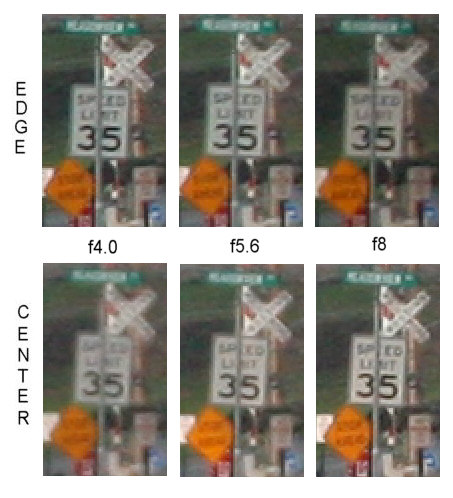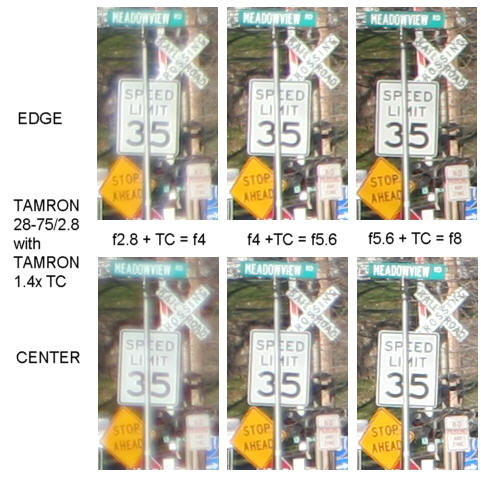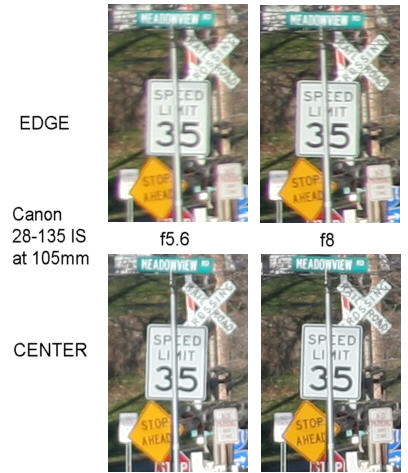
Tamron SP AF28-75/2.8 XR Di LD Aspherical (IF) Macro |
Tamron SP AF28-75/2.8 XR Di LD Aspherical (IF) Macro
Real ImagesThese are crops taken from displays of the full image at 200%. All were shot using an EOS 20D at ISO 400. They're not very aesthetic, but they do the job of illustrating performance! They look a little dull because they were taken in the rain!28mmFirst let's look at the Tamron 28-75 at 28mm:
Performance here is very good. You can see that center sharpness hold up even at full aperture (f2.8). Edge sharpness almost matches center sharpness except at f2.8, where it's a little softer. Overall though, performance is excellent. To give you a basis for comparison, below are similar shots taken with the Canon 28-135/3/5-5.6 IS USM. This is a lens which is regared as one of the better "consumer zooms".
Clearly this lens needs to be stopped down to about f5.6 to optimize center sharpness. At the edge no amount of stopping down gives an image equal to that in the center of the frame. Chromatic aberration is evident. I'd rate this performance as average. 50mmFirst, the Tamron 28-75/2.8 at 50mm: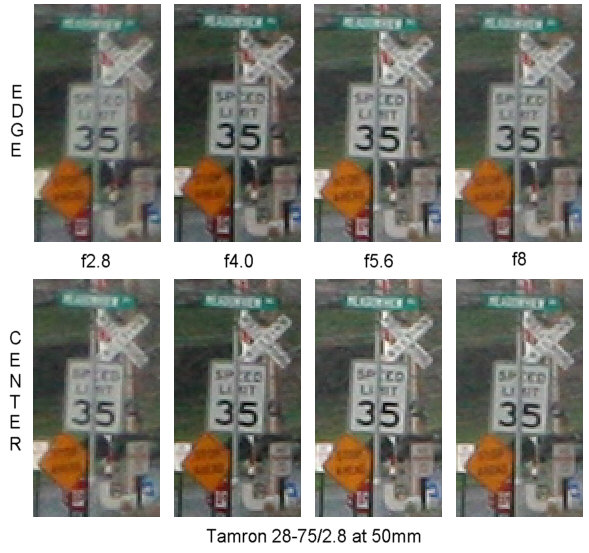
Again, good performance. Stopping down by one stop from wide open (i.e. to f4) does give a visisble increase in sharpness both in the center and at the edge of the frame. Center and edge performance are very close at f4 and smaller stops. Performance peaks at f5.6.
For comparison let's first look at a Canon 50/1.8 prime lens at the same f-stops:
Performance is very similar, with perhaps slightly better center sharpness at f2.8. Again stopping down to f4 is needed to bring up the edge sharpness.
Finally let's look at the Canon 28-135/3.5-5.6: Not much doubt that both the Tamron 28-75/2/8 and the Canon 50/1.8 are better performers. Interestingly, edge performance is a little better than center performance here. This is not something you see all the time, but it's not particularly unusual in zoom lenses at some zoom settings. I'd add here that the SRF testing using Imtest also showed this to be the case. This lens is clearly best operated at f5.6 or f8. 75mmFor technical reasons we're looking at different tagets here and these are 100% crops not 200%, but that doesn't really matter.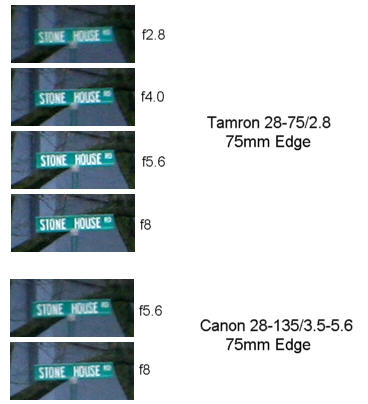
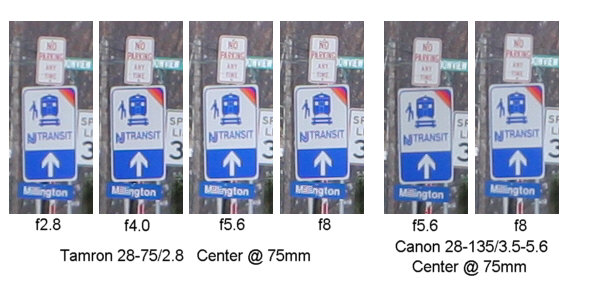
It's pretty clear that the Tamron 28-85/2.8 sharpens up a bit when stopped down from f2.8 to f4, especially at the edge of the frame. The Canon lens is pretty good at f5.6 (at 75mm f5.0 is "wide open" for this lens). Both lenses do well at f5.6 and f8 in the center and at the edge. The Tamron 28-75/2.8 does have a very slight edge in sharpness I think. Again this was confirmed in SRF tests. Both lenses would get a very good rating at 75mm. Performance with a 1.4x multiplierFinally here are 100% crops of some shots taken with the Tamron 28-75/2.8 plus a Tamron 1.4x multiplier. At 75mm the addition of a multipler makes the focal length 105mm. The sun came out for these images, so they look a little brighter than earlier shors!
The Canon 28-135 at 105mm isn't bad wide open - but wide open is f5.6. It's slightly better in the center than the Tamron lens, but it's softer at the edge. It does show a touch of chromatic abberation, which is not present in the Tamron images. ConclusionsThe Tamron SP AF28-75/2.8 XR Di LD Aspherical (IF) Macro is a good lens. It's well built, small, fast, light, sharp, flare resistant and affordable ($340 after rebate). It's about 1lb lighter and $800 cheaper than the Canon 24-70/2.8L.It does sharpen up a tad when stopped down from f2.8 to f4, but I've never seen an f2.8 (or faster) lens that didn't get better when stopped down, so this really isn't a strike against it. It's a reflection of the difficulty of controlling aberrations in fast lenses. Compared with the Canon 28-135/3.5-5.6 IS ($400) at the same f-stop, the Tamron is sharper and more resistant to flare, though of course the zoom range is less and it doesn't have IS. However the Tamron performs well with a Tamron 1.4x TC when zoomed to 75mm, especially when stopped down 1 stop, and so makes a very good 105/5.6 lens. Overall I have no hesitation in recommending the Tamron SP AF28-75/2.8 XR Di LD Aspherical (IF) Macro to anyone looking for a fast lens with this zoom range. The fact that it comes with a standard 6 year warranty is an added bonus. Where to buy
© Copyright Bob Atkins All Rights Reserved |
|||
|
|
